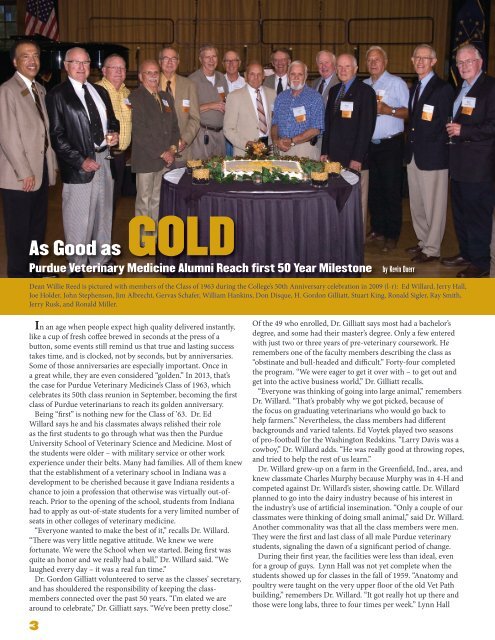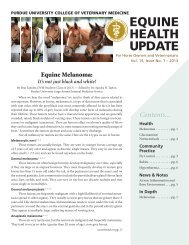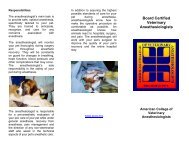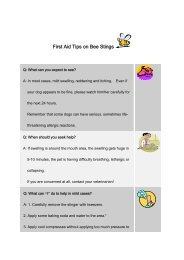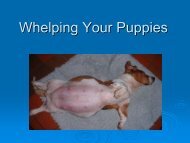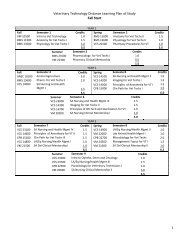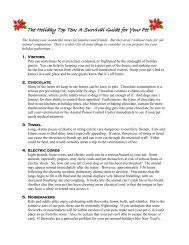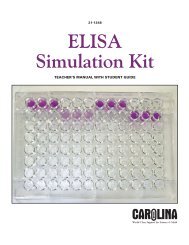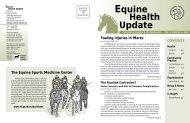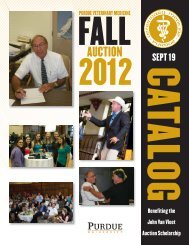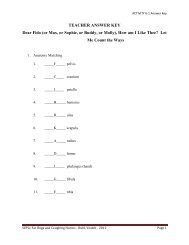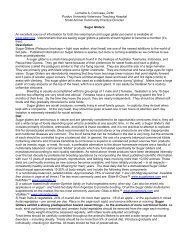2013 PVM Report - Purdue University School of Veterinary Medicine
2013 PVM Report - Purdue University School of Veterinary Medicine
2013 PVM Report - Purdue University School of Veterinary Medicine
Create successful ePaper yourself
Turn your PDF publications into a flip-book with our unique Google optimized e-Paper software.
GOLD<br />
As Good as<br />
<strong>Purdue</strong> <strong>Veterinary</strong> <strong>Medicine</strong> Alumni Reach first 50 Year Milestone<br />
by Kevin Doerr<br />
Dean Willie Reed is pictured with members <strong>of</strong> the Class <strong>of</strong> 1963 during the College’s 50th Anniversary celebration in 2009 (l-r): Ed Willard, Jerry Hall,<br />
Joe Holder, John Stephenson, Jim Albrecht, Gervas Schafer, William Hankins, Don Disque, H. Gordon Gilliatt, Stuart King, Ronald Sigler, Ray Smith,<br />
Jerry Rusk, and Ronald Miller.<br />
In an age when people expect high quality delivered instantly,<br />
like a cup <strong>of</strong> fresh c<strong>of</strong>fee brewed in seconds at the press <strong>of</strong> a<br />
button, some events still remind us that true and lasting success<br />
takes time, and is clocked, not by seconds, but by anniversaries.<br />
Some <strong>of</strong> those anniversaries are especially important. Once in<br />
a great while, they are even considered “golden.” In <strong>2013</strong>, that’s<br />
the case for <strong>Purdue</strong> <strong>Veterinary</strong> <strong>Medicine</strong>’s Class <strong>of</strong> 1963, which<br />
celebrates its 50th class reunion in September, becoming the first<br />
class <strong>of</strong> <strong>Purdue</strong> veterinarians to reach its golden anniversary.<br />
Being “first” is nothing new for the Class <strong>of</strong> ’63. Dr. Ed<br />
Willard says he and his classmates always relished their role<br />
as the first students to go through what was then the <strong>Purdue</strong><br />
<strong>University</strong> <strong>School</strong> <strong>of</strong> <strong>Veterinary</strong> Science and <strong>Medicine</strong>. Most <strong>of</strong><br />
the students were older – with military service or other work<br />
experience under their belts. Many had families. All <strong>of</strong> them knew<br />
that the establishment <strong>of</strong> a veterinary school in Indiana was a<br />
development to be cherished because it gave Indiana residents a<br />
chance to join a pr<strong>of</strong>ession that otherwise was virtually out-<strong>of</strong>reach.<br />
Prior to the opening <strong>of</strong> the school, students from Indiana<br />
had to apply as out-<strong>of</strong>-state students for a very limited number <strong>of</strong><br />
seats in other colleges <strong>of</strong> veterinary medicine.<br />
“Everyone wanted to make the best <strong>of</strong> it,” recalls Dr. Willard.<br />
“There was very little negative attitude. We knew we were<br />
fortunate. We were the <strong>School</strong> when we started. Being first was<br />
quite an honor and we really had a ball,” Dr. Willard said. “We<br />
laughed every day – it was a real fun time.”<br />
Dr. Gordon Gilliatt volunteered to serve as the classes’ secretary,<br />
and has shouldered the responsibility <strong>of</strong> keeping the classmembers<br />
connected over the past 50 years. “I’m elated we are<br />
around to celebrate,” Dr. Gilliatt says. “We’ve been pretty close.”<br />
Of the 49 who enrolled, Dr. Gilliatt says most had a bachelor’s<br />
degree, and some had their master’s degree. Only a few entered<br />
with just two or three years <strong>of</strong> pre-veterinary coursework. He<br />
remembers one <strong>of</strong> the faculty members describing the class as<br />
“obstinate and bull-headed and difficult.” Forty-four completed<br />
the program. “We were eager to get it over with – to get out and<br />
get into the active business world,” Dr. Gilliatt recalls.<br />
“Everyone was thinking <strong>of</strong> going into large animal,” remembers<br />
Dr. Willard. “That’s probably why we got picked, because <strong>of</strong><br />
the focus on graduating veterinarians who would go back to<br />
help farmers.” Nevertheless, the class members had different<br />
backgrounds and varied talents. Ed Voytek played two seasons<br />
<strong>of</strong> pro-football for the Washington Redskins. “Larry Davis was a<br />
cowboy,” Dr. Willard adds. “He was really good at throwing ropes,<br />
and tried to help the rest <strong>of</strong> us learn.”<br />
Dr. Willard grew-up on a farm in the Greenfield, Ind., area, and<br />
knew classmate Charles Murphy because Murphy was in 4-H and<br />
competed against Dr. Willard’s sister, showing cattle. Dr. Willard<br />
planned to go into the dairy industry because <strong>of</strong> his interest in<br />
the industry’s use <strong>of</strong> artificial insemination. “Only a couple <strong>of</strong> our<br />
classmates were thinking <strong>of</strong> doing small animal,” said Dr. Willard.<br />
Another commonality was that all the class members were men.<br />
They were the first and last class <strong>of</strong> all male <strong>Purdue</strong> veterinary<br />
students, signaling the dawn <strong>of</strong> a significant period <strong>of</strong> change.<br />
During their first year, the facilities were less than ideal, even<br />
for a group <strong>of</strong> guys. Lynn Hall was not yet complete when the<br />
students showed up for classes in the fall <strong>of</strong> 1959. “Anatomy and<br />
poultry were taught on the very upper floor <strong>of</strong> the old Vet Path<br />
building,” remembers Dr. Willard. “It got really hot up there and<br />
those were long labs, three to four times per week.” Lynn Hall<br />
3


